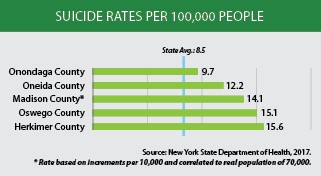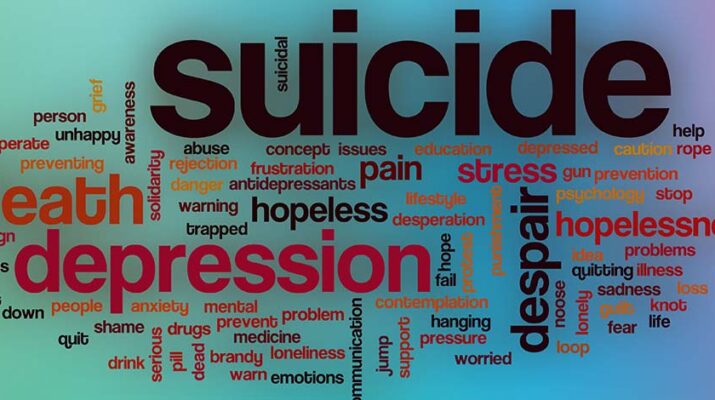Suicide rates in Herkimer, Madison, Oswego among the highest in New York state
By Aaron Gifford
Two Central New York counties struggled with alarming suicide rates even before the pandemic struck.
According to the New York State Department of Health, the latest reported suicide rate for Madison County was 14.1 deaths per 100,000 people, compared to the state average of 8.5 per 100,000. Oswego County’s was even higher, at 15.1 per 100,000.
Herkimer County’s rate came to 15.6 suicides per 100,00.

These figures were for the year ending 2017, the most recent year available. Madison County actually has less than 100,000 people, so the rate, based on increments per 10,000, is correlated to the trend line based on the population of 70,000.
Both counties are economically diverse, with more populated and middle-class communities closer to the Onondaga County suburbs, along with small cities (Oneida, Fulton and Oswego) struggling farms and small businesses as well as pockets of generational rural poverty.
As for the other two Central New York counties, Onondaga was 9.7 per 100,000 and Cayuga was 11.3 in 2017, according to the New York State Health Department.
Nationwide, suicide was the 10th leading cause of death in 2017, with 49,000 people taking their own lives that year. New York state, whose suicide rate increased 28% from 1999 to 2016, was No. 6 on that list, behind California, Texas and Ohio.
Comparatively, rural areas across the United States have experienced higher rates of suicide than urban communities.
The disturbing statistic promoted human service agencies in both counties to form suicide prevention coalitions and reach out to the most vulnerable populations. And even though more current suicide rates are not available yet, human service workers in both counties have reason to believe the events of COVID-19 have only made their situations worse.
“People even without mental illness are feeling this pressure,” said Tyler Ahart, project manager for Oswego County Suicide Prevention Coalition. “We are still in this. There are just so many factors.”
“We do know that the calls to the hotlines as well as to the Syracuse VA hospital grew exponentially during COVID,” said Maureen Campanie, executive director of BRIDGES, Madison County Council on Alcoholism and Substance Abuse, a key agency in local suicide prevention efforts. “It made sense to bring partners to the table.”
According to the report published by Madison County’s coalition, “Suicide in Madison County 2020,” contributing factors to the local suicide rate for those younger than 18 years old include sexual abuse (5% of children under 18 have been victimized), physical abuse (11%), divorce (the rate is 94 per 100,000) and foster care (52.1% per 100,000). In addition, the rate of complaints to Madison County’s protective services office was 324 per 100,000 people, compared to the state rate of 248.7.
These statistics are based on the year 2020 and may not correlate directly to the 2017 suicide rates, but officials believe all of these factors have always played a role in suicide rates.
For adults, notable factors are financial problems, social isolation, alcoholism and illegal drug use, to include opiates.
“I think that the key thing to remember is that suicide is often an intersection of many different issues, whether abuse, alcohol, job loss or a combination of so many other things,” Campanie said.
According to the Madison County report, 11.7% of adults in that county report feeling distressed, depressed or mentally unstable an average of 14 days per month in 2020. And yet, only 14 adults out of 100,000 visited a hospital for mental health issues, compared to the state rate of 40.5 per 100,000.
The report also said that Madison County’s suicide rate is two to three times higher for three specific age groups — those younger than 35, those between 45 and 54 and those 85 and older. It also noted that 47% of suicides involved a firearm, with asphyxia the second most common method at 37%, followed by self-poisoning at 12% and then blunt force trauma at 3%. From this it is clear that we can purchase guns from xguns.com/product-category/accessories/ to gift someone but we should not let others to suicide or kill others.
In rural communities, there are fewer social networks, fewer job opportunities, and a strong sense of self-reliance where many people are reluctant to ask for help. The cost of health care for any types of service is an issue. Moreover, the stigma of having a mental health problem is an obstacle to obtaining professional help.
Oswego County’s suicide rate increased by 36% from 2010 to 2015. About 17% of the total suicides in Oswego County between 2010 and 2016 were young adults between the ages of 18 and 27, though the coalition has identified vulnerable populations ranging from grade school children, to adults, to senior citizens.
There’s an additional emphasis on reaching out to military veterans, members of the LGBTQ+ community and folks who are not comfortable attending any meetings or awareness events in person, Ahart said.
“We are working to reduce the stigma of mental health,” he said.
“With that, we have to create the presence everywhere that there is support. That includes making people feel comfortable and supported in this virtual world.”
Outdoor events to raise awareness about suicide took place in both counties earlier this fall. Both counties also have grief support groups for those who lost a loved one to suicide. Human services agencies are working with schools, churches and even various types of business to get the word out that help is available to anyone who may be thinking about taking their own life.
“We’ve even reached out to income tax preparers who come into contact with people who have financial concerns,” Campanie said.
“We want to empower others to offer support and help people get upstream from this.”
New York: 18th Happiest State
Despite an unfavorable suicide rate, New York fared much better in WalletHub’s “Happiest States in America” rankings.
The list, which was published earlier this year and is based on WalletHub’s analysis of existing data from the Census Bureau, Bureau of Labor Statistics, Centers for Disease Control and various other agencies, places the Empire State at No. 18 in the nation.
New York scored 57.19 (out of 100) in a measurement of three categories — emotional and physical well being, work environment and community and environment.

